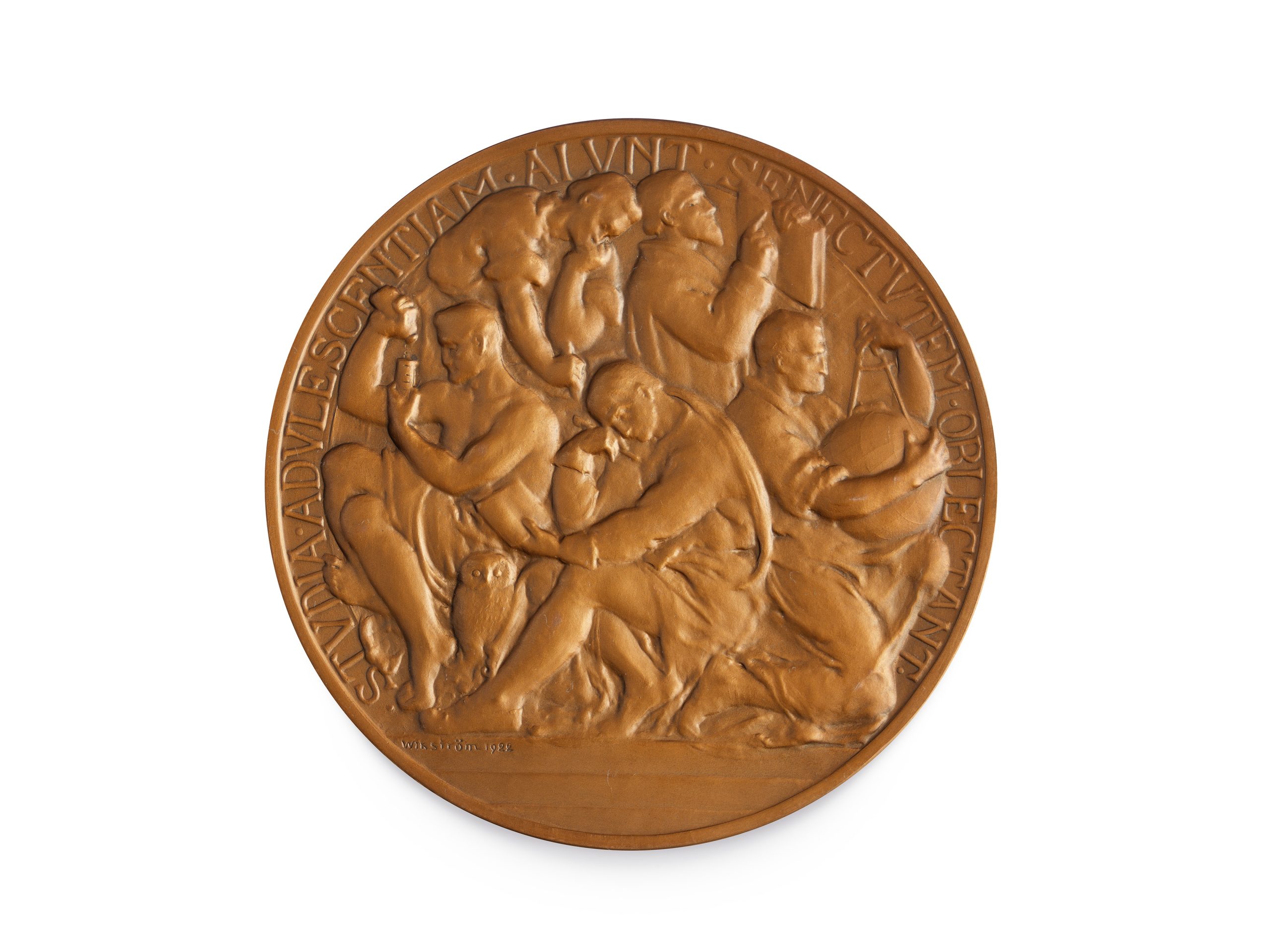Large commemorative medal for the establishment of the University of Turku
Turku-born Emil Wikström was a member of the committee established by artists and architects to embellish the premises of the Finnish University of Turku and participated in the art donations by sculpting the medal that was struck to inaugurate the University on 27 June 1922. In spring 1922, the artist described the origin of his work:
“– Yes, the medal. Here is a plaster version. The front shows the University’s coat of arms, the flying torch with the Finnish lion. As we all know, the designer for the coat of arms was artist Ehrström. It is circled by the text: ‘Turun Suomalainen Yliopisto. Avattu 27. p. kesäkuuta 1922.’ (‘The Finnish University of Turku. Inaugurated on 27 June 1922.’) The flip side has a motif that symbolises scientific endeavours. As you can see, it has a poet, a chemist, a doctor, a lawyer and an astronomer, although its intention is not to depict the University’s Faculties as such. Around the motif is a reference to Kalevala: ‘Lue synnyt syitä myöten, luottehet lomia myöten.’ (‘Utter magic spells, spells of origin, for healing.’) As known, the artists have decided to donate their works to the University, to be compiled in one room. We came up with the idea of striking a medal to cover the expenses of the artists’ room. The design of the medal is my donation to the University, and I tried to do my best. The bronze medal costs 50 Finnish Marks and all in all, we hope to collect around 100,000 Marks. This will be the last opportunity to assist the University; I think that even people with limited means will be able to participate.
In addition, 150 medals with Latin text will be stricken, of which 68 will be sent to universities, advanced scholars and friends of Finland abroad. This helps us preserve the memory of this great event, the inauguration of the first Finnish[-language] university, well into the future.”
In the description of Väinämöinen, the oldest of magicians, in Kalevala (canto 8:179–180), the Finnish word luote refers to particularly powerful words in spells, while lovet (here lomet) refers to the depths of the underworld, Manala. However, in this case, the word more likely refers to the deep and thorough analysis of matters. In the Finnish text, the verb has been changed to the imperative lue from the third person past tense used in Kalevala (luki), and the full English translation of the verses is: ‘Then his magic spells he uttered, / And himself began to speak them, / Spells of origin, for healing, / And to close the wound completely.’ (translation by W. F. Kirby). Instead of the phrase from Kalevala, the larger memorial medal bears the Latin phrase studia adulescentiam alunt, senectutem oblectant, which was proposed by V. A. Koskenniemi, and a text denoting the inauguration date. The Latin phrase is from Cicero’s speech “Pro Archia,” and the following extract is from the English translation by N. H. Watts from 1923 (the phrase in question is in italics): “Other pursuits belong not to all times, all ages, all conditions; but this [education] gives stimulus to our youth and diversion to our old age; this adds a charm to success, and offers a haven of consolation to failure. In the home it delights, in the world it hampers not. Through the night-watches, on all our journeying, and in our hours of country ease, it is our unfailing companion.”
The Turku University Foundation still grants the large commemorative medal of the University’s establishment in recognition of long service in the University’s administration and other means of promoting the University’s intellectual objectives or material wealth. The diameter of the smaller University of Turku commemorative medal, which is often granted to, for example, retiring professors, is 5 cm.
Emil Wikström (1864–1942) was the leading Finnish sculptor of public monuments of his generation. In the early decades of the 20th century, he kept apprentices in his studio in Visavuori, Sääksmäki. In exchange for their labour, he shared his know-how in bronze casting methods and monumental construction, which were rare in Finland at the time; the bronze casting shop that he built at his studio was the first of its kind in Finland. Raised in a modest Finnish-speaking family in Turku, the artist received thorough training in Turku, Helsinki, Vienna and Paris in the 1880s, primarily thanks to the support of benefactors in his hometown. Wikström designed a total of 38 medals during his career and received international recognition for them.
Tutta Palin 2024
Cicero. Pro Archia. Post Reditum in Senatu. Post Reditum ad Quirites. De Domo Sua. De Haruspicum Responsis. Pro Plancio. Transl. N. H. Watts. Loeb Classical Library 158. Cambridge, MA: Harvard University Press, 1923.
Hänninen, Helena, ed. Emil Wikström. Herkkyyttä ja voimaa. Mänttä: Gösta Serlachius Fine Arts Foundation, 2002.
Juhanpoika. “Kuvanveistäjäimme työpajoista. Käynti prof. E. Wikströmin luona.” Iltalehti, 15 May 1922.
Jäntere, Kaarlo. Turun yliopiston perustaminen. Helsinki: Oy. Suomen kirja, 1942.
Kalevala, The Land of Heroes, 1. Compiled by Elias Lönnrot, transl. W. F. Kirby. London: J. M. Dent & Co, 1907. The Project Gutenberg eBook, released 2 July 2008. https://www.gutenberg.org/cache/epub/25953/pg25953-images.html.
Tossavainen, Mari. Kuvanveistotyö. Emil Wikström ja kuvanveiston rakenne 1890–1920. Helsinki: Finnish Society of Sciences and Letters, 2012.




